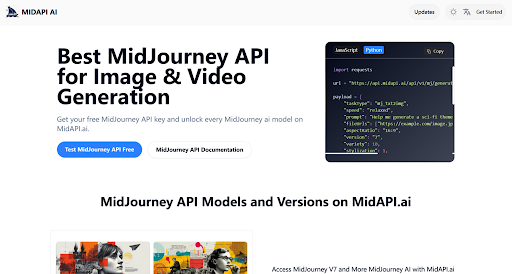
In the fast-moving world of generative AI, MidJourney has established itself as one of the most influential tools for creating images that balance artistic style with striking realism. From photorealistic renders to imaginative concept art, its models have been widely adopted by creators, designers, and businesses seeking high-quality visual outputs.
With the release of the MidJourney v7 API, these capabilities are no longer confined to Discord-based prompts. Developers can now access the same models through programmable endpoints, making it possible to embed AI image generation and AI video generation directly into applications and workflows. Platforms like MidAPI.ai provide streamlined API access, secure API key management, and transparent MidJourney API pricing, lowering the barrier for teams to move from experimentation to production.
What’s New in MidJourney v7 API Compared to Previous Versions
The MidJourney v7 API marks a clear step forward from earlier releases such as v6 and v6.1. Outputs generated with v7 show sharper details, more coherent structures, and greater consistency across variations. Prompts are interpreted with higher accuracy, which helps both the MidJourney image API deliver results that feel more intentional and less random. Video generation also benefits, as the MidJourney image to video API produces smoother motion with fewer distortions. Together, these improvements make v7 not only more reliable for creative exploration but also more practical for commercial use.
Key Capabilities of the MidJourney API for Image and Video Generation
Text-to-Image Generation
With the MidJourney text to image API, developers can transform descriptive prompts into detailed visuals. The API supports multiple aspect ratios and versions, including the latest MidJourney v7 API, allowing teams to create images tailored for social media, web, or print.
Image-to-Image Transformation
The MidJourney image to image API enables refinement of existing images, whether to adjust style, create variations, or expand a concept. This makes it useful for applications like product design, branding, or iterative artwork.
Image-to-Video Conversion
The MidJourney image to video API turns still images into short dynamic clips, with options to extend videos by 4 seconds at a time. Developers can choose between manual extension using prompts or automatic AI-generated continuity, making it suitable for marketing or storytelling.
Upscaling and Variations
The MidJourney v7 API includes features like Upscale, which enhances resolution for high-quality outputs, and Vary, which generates stylistic variations while preserving the base composition. These are particularly valuable for projects requiring both flexibility and consistency.
Omni Reference for Object Consistency
Using the Omni Reference mode, developers can preserve key elements—such as characters, objects, or logos—across new generations. This ensures continuity in creative projects where brand identity or character design must remain consistent.
Affordable and Flexible MidJourney API Pricing
Pricing often determines whether an API is suitable for small-scale testing or enterprise-level adoption. With MidAPI.ai, the MidJourney API uses a straightforward credit-based system instead of fixed subscriptions. Developers only pay for the content they generate, starting from as little as $5 in credits. Credits can be purchased in varying amounts, and larger bundles come with discounts—making the model cost-effective for both individuals and teams.
Each image created through the MidJourney image API costs as little as $0.015, while a five-second video generated with the MidJourney video API starts at $0.075. This transparent structure ensures that budgets remain predictable while leaving creative output unrestricted. Whether experimenting with the MidJourney v7 API or scaling production workflows, developers benefit from pricing that adapts to their needs.
How to Integrate the MidJourney API with MidAPI.ai
Generate Your MidJourney API Key
Begin by creating an account on MidAPI.ai and obtaining your API key. The platform allows IP whitelisting and usage restrictions, which provide an added layer of security for production environments.
Review the MidJourney API Documentation
Before sending requests, familiarize yourself with the official documentation. It outlines key parameters such as prompt, aspectRatio, and version (including the MidJourney v7 API). Understanding these options helps you configure tasks correctly and avoid wasting credits.
Create and Manage Generation Tasks
Use the MidJourney text to image API, image to image API, or image to video API to start generating content. Each request creates a task that can be tracked via task IDs. Developers can also extend videos, upscale images, or generate variations, making the MidJourney API access highly versatile.
Monitor Usage and Handle Results
MidAPI.ai offers callbacks to notify you when a task is complete, reducing the need for constant polling. Since generated files are only stored for 15 days, it is best practice to download or archive results promptly. Usage logs and credit alerts also help manage costs under the MidJourney API pricing model.
Integration Tips for the MidJourney API
Even though the MidJourney API is straightforward to use, thoughtful integration can make a big difference in performance, reliability, and long-term scalability. Here are three tips worth considering:
Design for Asynchronous Workflows
Image and video generation can take time. Rather than blocking your application while waiting, use callbacks or background jobs so that your system remains responsive. This is particularly important if you’re embedding the MidJourney image API or video API into user-facing products.
Balance Cost with Quality
The API offers multiple speed modes and model versions, including the MidJourney v7 API for higher fidelity. Consider when “fast enough” is sufficient and when premium quality is worth the additional credits. Clear cost-performance tradeoffs will keep your use of MidJourney API pricing predictable.
Think Beyond Single Outputs
The real power of the MidJourney API comes from chaining features together. A text-to-image request can be followed by upscaling, generating variations, or even turning the result into a short video. Structuring your workflows this way makes the API more than just a tool for one-off generations—it becomes part of a creative pipeline.
Conclusion: From Creative Exploration to Practical Integration with the MidJourney API
The MidJourney v7 API demonstrates how generative AI has matured into a tool that serves both creativity and practical development. With support for text-to-image, image-to-image, and image-to-video generation, as well as features like upscaling, variations, and Omni Reference, it extends beyond artistic experimentation into reliable workflows.
By offering clear API documentation, flexible API pricing, and secure API key management, platforms like MidAPI.ai make it easier for developers to integrate MidJourney into applications, scale projects, and maintain predictable costs. In this way, the MidJourney API is not just about producing visuals—it becomes part of building scalable, production-ready systems.

